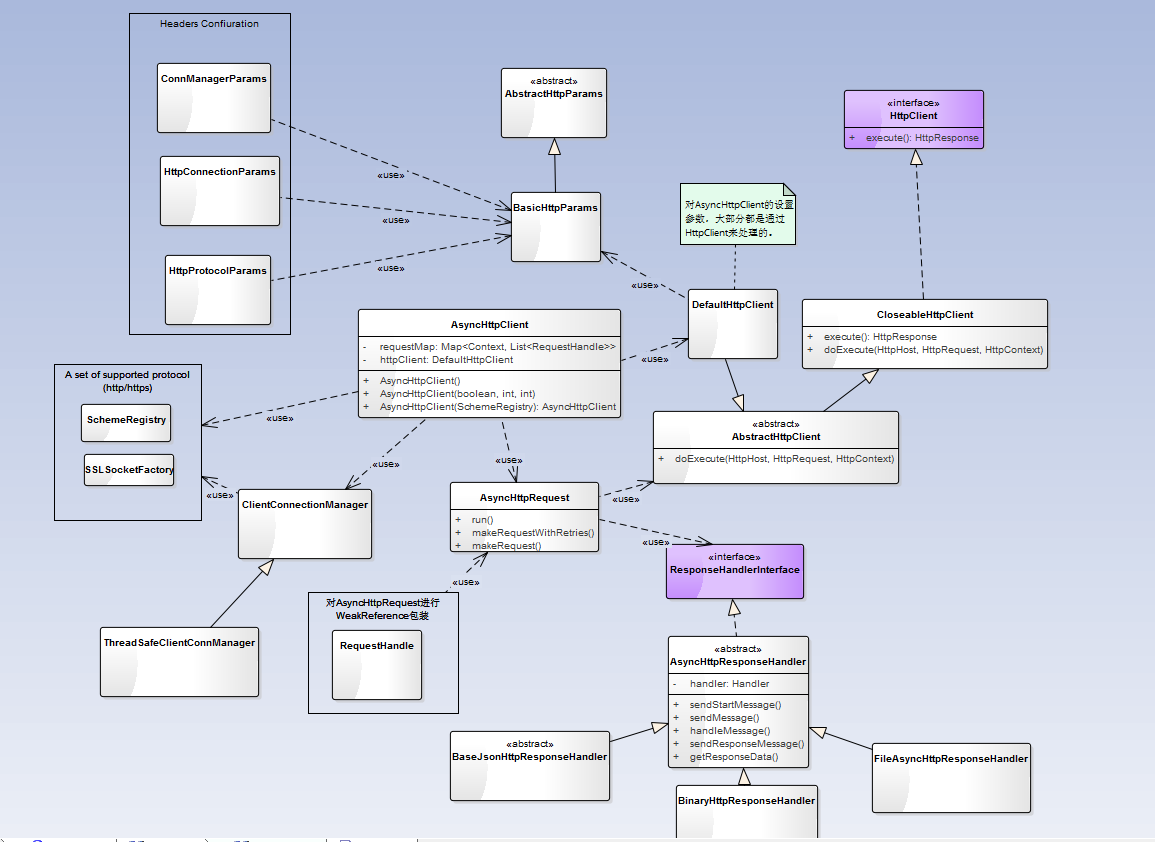android-async-http解析和使用
loopj/android-async-http github地址
官网
Features
- Make asynchronous HTTP requests, handle responses in anonymous callbacks
发送异步http请求,在匿名callback对象中处理response信息; - HTTP requests happen outside the UI thread
http请求发生在UI(主)线程之外的异步线程中; - Requests use a threadpool to cap concurrent resource usage
内部采用线程池来处理并发请求; - GET/POST params builder (RequestParams)
通过RequestParams类构造GET/POST,Builder方式。 - Multipart file uploads with no additional third party libraries
内置多部分文件上传,不需要第三方库支持; - Tiny size overhead to your application, only 60kb for everything
和你的app大小相比来说,库的size很小,所有的一切只有90kb; - Automatic smart request retries optimized for spotty mobile connections
在各种各样的移动连接环境中具备自动智能请求重试机制; - Automatic gzip response decoding support for super-fast requests
自动的gzip响应解码 - Optional built-in response parsing into JSON (JsonHttpResponseHandler)
内置多种形式的响应解析,有原生的字节流,string,json对象,甚至可以将response写到文件中 - Optional persistent cookie store, saves cookies into your app’s SharedPreferences
cookie保存,内部实现用的是Android的SharedPreferences;
AsyncHttpClient 使用demo
1 | AsyncHttpClient client = new AsyncHttpClient(); |
整体操作流程
android-async-http最简单基础的使用只需如下步骤:
1、创建一个AsyncHttpClient;
2、(可选的)通过RequestParams对象设置请求参数;
3、调用AsyncHttpClient的某个get方法,传递你需要的(成功和失败时)callback接口实现,一般都是匿名内部类,实现了AsyncHttpResponseHandler,类库自己也提供许多现成的response handler,你一般不需要自己创建。
一、先创建一个AsyncHttpClient
AsyncHttpClient client = new AsyncHttpClient();
1、创建SchemeRegistry,用于定义支持哪种协议(目前只支持http/https)
1
2
3
4
5
6
7
8
9
10
11
12
13
14
15
16
17
18private static SchemeRegistry getDefaultSchemeRegistry(boolean fixNoHttpResponseException, int httpPort, int httpsPort) {
//省略一系列参数判断。
// Fix to SSL flaw in API < ICS
// See https://code.google.com/p/android/issues/detail?id=13117
SSLSocketFactory sslSocketFactory;
if (fixNoHttpResponseException) {
sslSocketFactory = MySSLSocketFactory.getFixedSocketFactory();
} else {
sslSocketFactory = SSLSocketFactory.getSocketFactory();
}
SchemeRegistry schemeRegistry = new SchemeRegistry();
schemeRegistry.register(new Scheme("http", PlainSocketFactory.getSocketFactory(), httpPort));
schemeRegistry.register(new Scheme("https", sslSocketFactory, httpsPort));
return schemeRegistry;
}2、初始化请求参数BasicHttpParams,添加Header
1
2
3
4
5
6
7
8
9
10
11
12BasicHttpParams httpParams = new BasicHttpParams();
ConnManagerParams.setTimeout(httpParams, connectTimeout);
ConnManagerParams.setMaxConnectionsPerRoute(httpParams, new ConnPerRouteBean(maxConnections));
ConnManagerParams.setMaxTotalConnections(httpParams, DEFAULT_MAX_CONNECTIONS);
HttpConnectionParams.setSoTimeout(httpParams, responseTimeout);
HttpConnectionParams.setConnectionTimeout(httpParams, connectTimeout);
HttpConnectionParams.setTcpNoDelay(httpParams, true);
HttpConnectionParams.setSocketBufferSize(httpParams, DEFAULT_SOCKET_BUFFER_SIZE);
HttpProtocolParams.setVersion(httpParams, HttpVersion.HTTP_1_1);
3、根据schemeRegistry 和 httpParams创建连接管理 ClientConnectionManager
1
ClientConnectionManager cm = createConnectionManager(schemeRegistry, httpParams);
4、创建线程池
1
threadPool = getDefaultThreadPool();
5、根据cm和httpParams创建HttpClient
Creates a new HTTP client from parameters and a connection manager.1
httpClient = new DefaultHttpClient(cm, httpParams);
6、调用httpClient addRequestInterceptor和addResponseInterceptor,设置请求和反馈回调.
1
2
3
4
5
6
7
8
9
10
11
12
13
14
15
16
17
18
19httpClient.addRequestInterceptor(new HttpRequestInterceptor() {
@Override
public void process(HttpRequest request, HttpContext context) { //省略
}
});
httpClient.addResponseInterceptor(new HttpResponseInterceptor() {
@Override
public void process(HttpResponse response, HttpContext context) {
//省略
}
});
httpClient.addRequestInterceptor(new HttpRequestInterceptor() {
@Override
public void process(final HttpRequest request, final HttpContext context) throws HttpException, IOException {
//省略
}
}, 0);最后setHttpRequestRetryHandler,设置重试的Handler
1
httpClient.setHttpRequestRetryHandler(new RetryHandler(DEFAULT_MAX_RETRIES, DEFAULT_RETRY_SLEEP_TIME_MILLIS));
二、通过RequestParams对象设置请求参数;
传入key-value的键值对,作为请求参数
三、请求
1 | public RequestHandle get(String url, ResponseHandlerInterface responseHandler) { |
1 | protected RequestHandle sendRequest(DefaultHttpClient client, HttpContext httpContext, HttpUriRequest uriRequest, String contentType, ResponseHandlerInterface responseHandler, Context context) { |
最后官网推荐使用Static Http Client
Recommended Usage: Make a Static Http Client1
2
3
4
5
6
7
8
9
10
11
12
13
14
15
16
17
18
19import com.loopj.android.http.*;
public class TwitterRestClient {
private static final String BASE_URL = "https://api.twitter.com/1/";
private static AsyncHttpClient client = new AsyncHttpClient();
public static void get(String url, RequestParams params, AsyncHttpResponseHandler responseHandler) {
client.get(getAbsoluteUrl(url), params, responseHandler);
}
public static void post(String url, RequestParams params, AsyncHttpResponseHandler responseHandler) {
client.post(getAbsoluteUrl(url), params, responseHandler);
}
private static String getAbsoluteUrl(String relativeUrl) {
return BASE_URL + relativeUrl;
}
}
1 | import org.json.*; |
类图

#其他的用法见官网
- Persistent Cookie Storage with PersistentCookieStore
- Adding GET/POST Parameters with RequestParams
- Uploading Files with RequestParams
- Downloading Binary Data with FileAsyncHttpResponseHandler
- Adding HTTP Basic Auth credentials